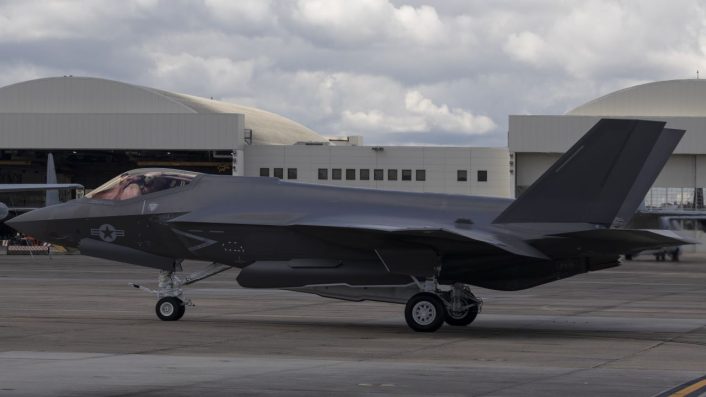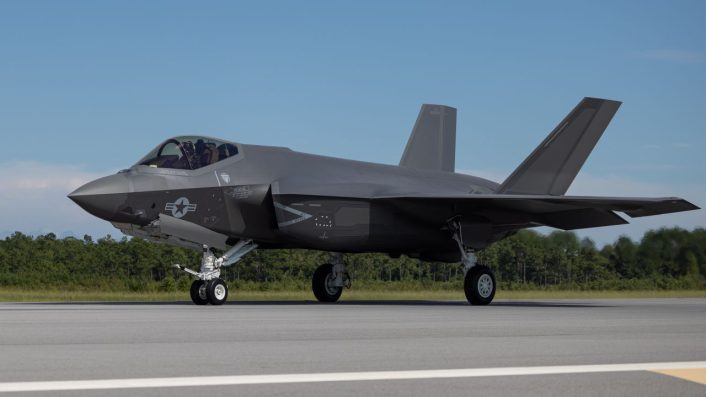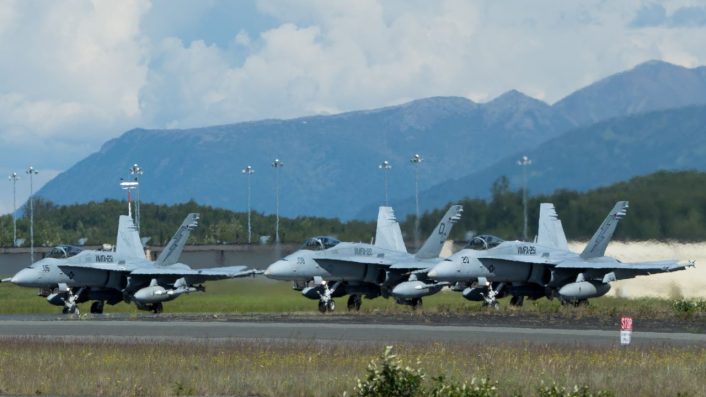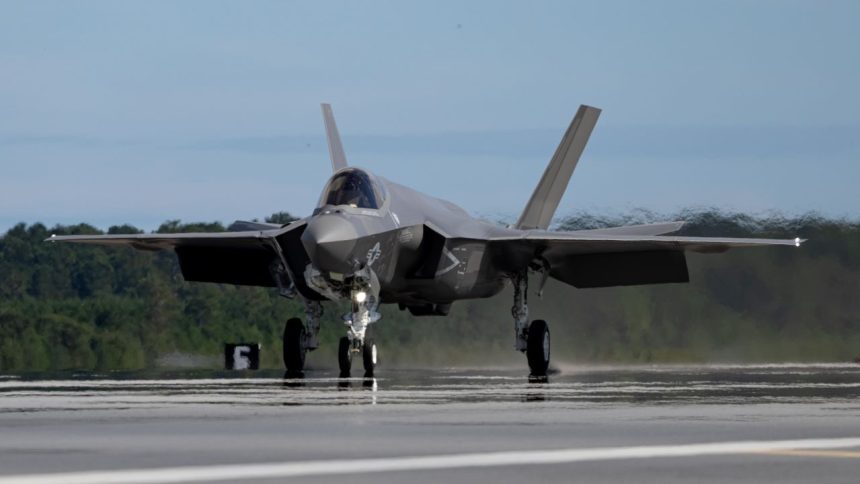VMFA-251 is the first East Coast operational unit to receive the F-35C, whose arrival at MCAS Cherry Point marks the beginning of the 2nd MAW’s transition from the F/A-18 Hornet to the fifth generation stealth jet.
The U.S. Marine Corps’ Marine Fighter Attack Squadron (VMFA) 251 received its first F-35C Lightning II jet on Sept. 17, 2024, at Marine Corps Air Station (MCAS) Cherry Point, North Carolina. The delivery makes VMFA-251 the first East Coast operational F-35C squadron, said a statement from the Corps. VMFA-251 is part of Marine Aircraft Group 14 (MAG-14) within the 2nd Marine Aircraft Wing (MAW 2), the aviation combat element of the 2nd Marine Expeditionary Force (II MEF).
The F-35C’s arrival at MCAS Cherry Point marks the beginning of the 2nd MAW’s operational transition from legacy fixed-wing tactical aircraft to the fifth generation stealth jet. The unit’s previous aircraft was the F/A-18C/D Hornet, which the squadron, also known as the “Thunderbolts” or the “T-Bolts”, began flying in 1986. VMFA-251 was deactivated on Apr. 23, 2020, after 34 years of service, during a ceremony at MCAS Beaufort, South Carolina, to begin inducting F-35 fighters.
The deactivation followed the return from deployment in Operation Inherent Resolve. The squadron then relocated to MCAS Cherry Point to commence its F-35 transition and is currently in the “process of official reactivation and working towards receiving its Safe for Flight certification,” according to the service. The USMC described the F/A-18 as a combat-proven single and dual-seat multi mission tactical aircraft, which was the first jet “designed from its inception to carry out both air-to-air and air-to-ground missions.”
Today, VMFA-251 received their first F-35C Lightning II.
VMFA-251 became the first East Coast-based @USMC squadron to receive the F-35C, designed to operate from conventional aircraft carriers or land bases and provides operational flexibility and persistence to @iimefmarines. pic.twitter.com/vELqkHxEb2
— 2nd Marine Aircraft Wing (@2nd_MAW) September 17, 2024
F-35s are the tip of the spear
The F-35C, with its larger wingspan compared to the F-35A used by the U.S. Air Force, is CATOBAR (Catapult Assisted Take-Off But Arrested Recovery) variant meant to operate from aircraft carriers and short runways. The Marines also fly the F-35B, a STOVL (Short Take-Off Vertical Landing) jet that has a vertical-lift fan on the spine and a downward thrust-vectoring engine nozzle to allow jet-borne operations in addition to forward flight.
The F-35C’s ability to operate from conventional aircraft carriers and land bases “provides operational maneuverability and persistence to the MAGTFs (Marine Air-Ground Task Force),” says the service. “Superior internal fuel capacity results in a significantly increased combat radius and longer on-station times as compared to the F-35B,” added the press release.
The Marines describe the 5th generation F-35 as an aircraft sporting “advanced stealth, agility and maneuverability, sensor and information fusion, and provides the pilot with real-time access to battlespace information.” They further note “it is designed to meet an advanced threat, while improving lethality, survivability, and supportability.”

The reference to the F-35’s pioneering sensor fusion, data processing capability with three million lines of software code, and DAS (Distributed Aperture System)-enabled situational awareness, is also in line with how The Aviationist has assessed the jet’s tactical and doctrinal orientation. Despite its troubled history of crashes and delays, it is still a tremendously capable aircraft and something that peer rivals Russia and China are aware of.
Extra ‘punch’ for the U.S. Marine Corps
“Today’s arrival of our first carrier-based, fifth-generation fighter-attack aircraft represents an enormous milestone for MAG-14, MCAS Cherry Point, 2nd MAW, and the F-35 community,” said Colonel Benjamin Grant, commanding officer, MAG-14.
As mentioned earlier, the delivery marks the beginning of Marines’ F-35C operations on the East coast, as the two other F-35C units, VMFA-314 and VMFA-311 are on the West Coast at MCAS Miramar, California. VMFA-251 will now become the 15th USMC squadron equipped with the F-35, adding to the two other F-35C squadrons and 12 F-35B squadrons.
“The one-two punch provided by the F-35C’s increased range and the F-35B’s STOVL capability will give MAG-14 (Marine Aircraft Group 14) and the MAGTF (Marine Air-Ground Task Force) a significant advantage in the future fight,” added the commander. “I’m proud of the team of Marines and Sailors at MAG-14 and VMFA-251 for their professionalism and dedication, and grateful for our partners in the Marine Corps and the joint force that made today’s event possible.”
“The F-35C Lightning II brings tremendous combat power to 2nd MAW, MAG-14, and MCAS Cherry Point. Its incredible range, firepower, sensors, and survivability, coupled with the fact that it is truly a Joint aircraft, makes it a lethal asset for Marine aviation,” said VMFA-251’s Commanding Officer Lt. Col. Evan Shockleym, who flew the first F-35 to the base. “The T-Bolts of VMFA-251 are excited to accept these aircraft, reactivate the squadron in the coming months, and carry their legacy forward.”

Existing Marine Fighter Attack Squadrons like the VMFA-232 at MCAS Miramar, which are still operating F/A-18s, are meanwhile adopting new weapons, like the AGM-158A JASSM (Joint Air-to-Surface Standoff Missile). The unit conducted its first “ordnance operations” with the JASSM, where the weapon was put through loading procedures, connection of hardware and software components, as a required protocol before its incorporation in the Marine Corps arsenal.
Marine units transitioning to the F-35
The development also comes after the VMFA-311 “Tomcats”, assigned to MAG 11, 3rd MAW, operating the F-35C Lightning II, became the second Marine squadron to declare IOC (Initial Operating Capability) with the new jet on Jul. 31, 2024. Until disbanding in 2020, the squadron was known as VMA-311 and operated the AV-8B Harrier II.
VMFA-314, which also operates the F-35C and was the first Hornet unit to transition to the stealth jet, is among 14 active Marine F-35 squadrons that fly the F-35. Of these, 12 are equipped with the F-35B. One of these is the VMFA-542 under the 2 MAW, also at MCAS Cherry Point, operating the jet’s STOVL variant. That squadron became the first East Coast squadron to achieve IOC with the F-35B Lightning II on Feb. 8, 2024.

The USMC plans to operate the Hornet until 2030, with a number of squadrons already transitioning to the new aircraft. VMFA-251 is set to be fully established as an F-35C unit by 2025, while VMFA-115 will follow by 2027.









